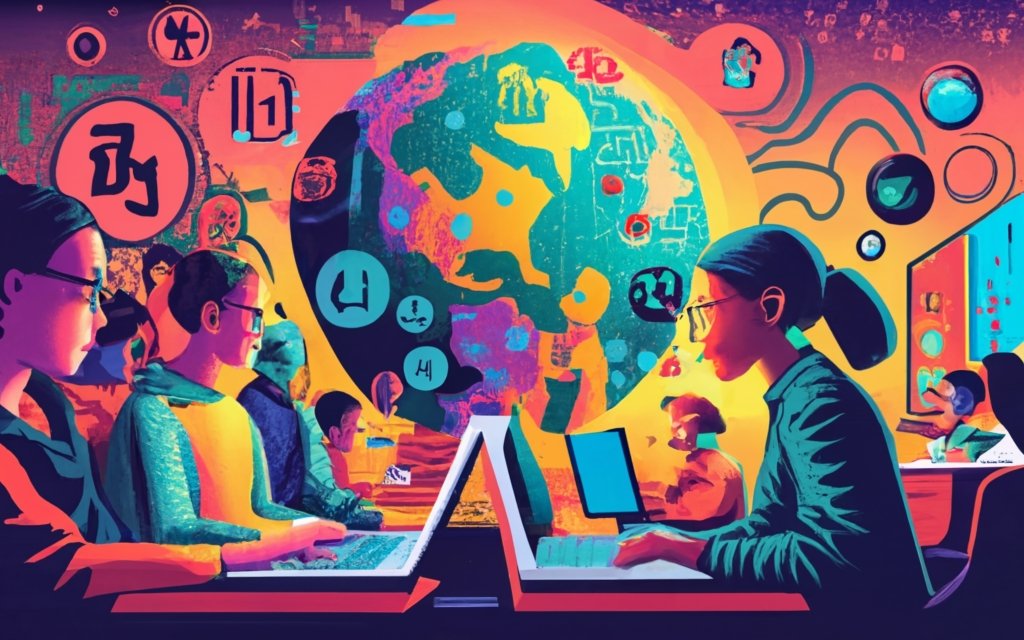As educators, we can enhance students’ access and knowledge of using AI strategically as an academic tool, or we can hinder it. Larry Cuban, professor emeritus of education at Stanford University, has stated frankly that teachers are the gatekeepers of technology. As such, there are several ways that we can play a pivotal role in bridging the digital divide as it relates to AI. But what does that mean?
What is the digital divide?
The term “digital divide” emerged in the mid-1990s and gained prominence towards the end of the decade. It was first used in its current context to describe the gap between those with and without access to digital technology and the Internet. One of the earliest and most influential reports to bring attention to the digital divide concept was the Falling Through the Net series, published by the U.S. Department of Commerce’s National Telecommunications and Information Administration (NTIA), starting in 1995.
These reports played a significant role in popularizing the term and bringing the issue to the forefront of public policy discussions. The term “digital divide” quickly became a key concept in discussions about internet access, technology policy, and social inequality, and it remains a critical issue in the digital age, continually evolving as technology advances and access issues change.
What causes the digital divide?
The digital divide is made worse when disparities (economic, geographical, educational, and/or support systems) occur. These disparities often occur over time and may be hard to resolve without intentional focus and effort. Now that AI has burst on the scene, many fret that it may increase the digital divide that currently exists. In actuality, it is not the technology (Internet, devices, AI, etc.) that is increasing the divide but those in charge of the technology, funding, and legislation.
Let’s look at several key ways educators can work to bridge the digital divide.
1. Promote Digital Literacy Across the Board

Bridge the digital divide by working to ensure that all students, regardless of their background, have a strong foundation in digital literacy. This includes not only the basics of computer use but also an understanding of how AI works and its implications for society. By integrating digital literacy into the curriculum at all levels, teachers can help students become savvy digital citizens and prepare them for a future where AI is ubiquitous. This could involve hands-on projects, critical discussions about technology, and lessons on digital ethics and safety.
2. Advocate for Equitable Access to Technology

You can be a powerful advocate for change within the education system and reduce the digital divide by voicing the need for equitable access to technology. You can push for policies and funding that provide all students with the devices and internet access needed to benefit from AI educational tools. This might mean lobbying for school budgets to include provisions for technology, seeking grants or partnerships with tech companies, or working with community organizations to set up after-school programs that offer access to AI resources.
3. Design an Inclusive AI Curriculum

When educators are involved in designing and implementing AI educational tools, they can ensure that these resources are inclusive and cater to a diverse student body, decreasing the digital divide. This means advocating for AI that is designed with diverse datasets and algorithms that are free from bias. It also means creating lesson plans that use AI to support all students, including those with special needs or those who speak different languages. By tailoring the use of AI to meet the needs of all learners, you can help prevent the technology from becoming another barrier to education.
As educators, we have the power to shape the future of our students in this rapidly evolving digital age. Let’s use our role as gatekeepers of technology and advocates for equitable access. I encourage you to integrate digital literacy into your curriculum, champion inclusive AI tools, and strive for a classroom where every student has the opportunity to thrive. Together, we can bridge the digital divide and create a brighter future for all our students.
Additional Reading: AI and Education in the News
How AI Could Bring Big Changes to Education — And How to Avoid Worst-Case Scenarios
Educators are adapting to AI like ChatGPT, debating its dual impact on cheating and time-saving. A study by scholars anticipates AI’s potential to reshape society, posing questions on education’s role. Scenarios envisage AI altering knowledge work and challenging literacy’s relevance. The study urges proactive measures by leaders to harness AI’s benefits and avoid worst-case outcomes. Discussions emphasize the necessity for comprehensive preparation amid AI’s evolving role in education and society. >> Read more
Khan Academy CEO Says Using AI in Education is ‘An Imperative’ at Harvard-MIT Event
Sal Khan, CEO of Khan Academy, emphasized AI’s crucial role in education at a Harvard-MIT event. Reflecting on the launch of ChatGPT and Khan Academy’s AI chatbot “Khanmigo,” he noted initial skepticism but highlighted their benefits in guiding students through exercises and preventing plagiarism in essays. Khan envisioned AI’s impact on job roles, suggesting a shift towards higher-level tasks. He also discussed AI’s potential influence on filmmaking and proposed redirecting AI use toward positive educational aims.
How Generative AI Is Changing Employee Productivity
Chief product officer of Discovery Education, Pete Weir, shared insights with Business Insider on integrating generative AI to streamline tasks, improve productivity, and guide employee exploration within company boundaries. Weir discussed AI’s role in aggregating feedback efficiently and cautioned against undue tech adoption. He emphasized a strategic approach, ethical use, and clear communication while harnessing AI’s potential to enhance educational support and not replace teachers.
*Note: Article summaries were generated by ChatGPT.

